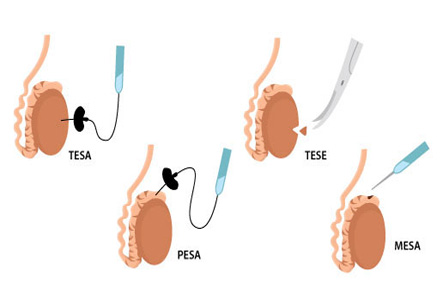Surgical Sperm Retrieval
Introduction
Surgical sperm retrieval includes a series of operative procedures which are designed to help gather sperm from a man who would otherwise have difficulty producing it. SSR treatments are solutions for male infertility. The sperm are directly removed from the man’s genitalia by surgery.
About 10% of those with male infertility have semen that contains no sperm. This can be the result of a number of causes such as:
• Blockage in the vas deferens (the tube which carries the sperm to the penis)
• Absent vas deferens
• Blockage in the epididymis
• Cystic fibrosis
In some men, sperm are produced but not present in their semen, for example in cases of retrograde ejaculation

These men mostly produce healthy sperm which can be retrieved by SSR techniques.
About one man in a hundred produces no sperm in the testis. This condition is known as azoospermia. This can occur be due one of the following reasons:
1. Vasectomy or male sterilization
2. Illness such as mumps in adolescence
3. Trauma to groin region
4. Genetic disorder
A few of these men with azoospermia may beget a child after surgical retrieval of sufficient sperm directly from the testes for use in the ICSI or direct sperm microinjection procedure. SSR is usually not much effective in such cases.
In some men, sperm are produced but not present in their semen, for example in cases of retrograde ejaculation. They can also be benefitted by surgical retrieval.
The goals of surgical sperm retrieval are:
1. To obtain the best quality sperm possible
2. To gather an adequate number of sperm for both immediate use and for storage by cryopreservation
3. To minimize damage to the reproductive tract during surgery so as not to jeopardize further attempts at sperm retrieval or surgical reconstruction if any.
Types of Surgical Sperm Retrieval
There are a number of different types of surgical sperm retrieval. Depending upon the cause of the lack of sperm in the semen, the type of treatment is decided. Overall effectiveness depends upon the type of fertilization method the couple chooses to use for conceiving. With most types of SSR, the sperm retrieved is immature and must be implanted using ICSI.
Vasal Aspiration: Vasal aspiration is an easy procedure done under local anesthesia. Candidates for this procedure are those with an obstructed vas deferens or men who have had a vasectomy within five years. A syringe is inserted into the vas deferens and the liquid inside is aspirated. The vas deferens is massaged in order to produce more liquid. This is the only SSR procedure that retrieves mature sperm.
Percutaneous Sperm Aspiration (PESA): PESA is usually the initial treatment option for infertile men. This procedure is short and relatively painless. There is no need of surgical incision. Fluid is removed from epididymis by fine needle inserted through the scrotum into the epididymis. This liquid is then analyzed for sperm content and motility. This procedure takes about 10 to 20 minutes. It is done under local anesthesia.
Micro-epididymal Sperm Aspiration (MESA): MESA is a microsurgical treatment that requires general anesthetic. A small incision is made through the scrotuminto the epididymis with a microsurgical instrument. Any fluid is then drained off and taken for microscopic examination.
Testicular Sperm Extraction (TESE): If there are no sperm in the epididymal fluid, a needle is inserted into the testis. This needle removes a small sample of tissue, which is then examined for sperm. A variant of this procedure involves a small surgical incision in the testis, called a testicular biopsy. This procedure requires general anesthetic. Full recovery is usually accomplished within three days.
Possible Complications:
Surgical sperm retrieval is relatively risk-free. It is important to perform these procedures in the hands of an experienced surgeon. The main risks for these procedures include bleeding and infection but they are relatively rare. Any procedures that require anesthetic will also carry an increased risk.
Effectiveness of Surgical Sperm Retrieval:
Surgical sperm retrieval has varying success rates depending upon the procedure chosen. The sperm taken from inside the body are not matured, so they cannot successfully fertilize an egg using in vitro fertilization techniques. Only vassal aspiration produces sperm that are mature enough to be used with this method.
For all other methods of SSR, ICSI is the procedure of choice for fertilization. PESA is associated with high retrieval rates of about 80% and 90%. However, the pregnancy success rate is low for this procedure.
MESA is associated with better pregnancy rates when used with ICSI. TESE success rates are much lower.